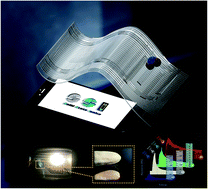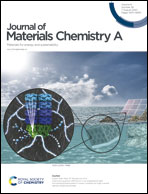Flexible and transparent sensors for ultra-low NO2 detection at room temperature under visible light illumination†
Abstract
Metal oxide based gas sensors should mostly work at high temperatures; the high working temperature is associated with safety concerns and high energy consumption, which makes portable and wearable devices almost impossible, and the inhomogeneous temperature distribution over a sensor also has a detrimental effect on the device performance. However, all the above problems can be effectively resolved by using visible light-excited sensors working at room temperature. By depositing an array of well-aligned In2O3 nanowires on polyimide (PI) substrates, we fabricate flexible and transparent sensors that achieve room temperature gas sensing using visible light as the excitation source. The detection limit to NO2 is as low as 10 ppb under illumination using both monochromatic (blue) and polychromatic (white) light sources. The sensing performance remains consistent after repetitive bending and long-term operation. Remarkably, the sensor exhibits recoverable response to 500 ppb NO2 even under the illumination of an iPhone screen with a low irradiance of 0.56 W m−2. Through a systematic study of the interaction between the photoelectric and gas sensing properties of the materials, we also explore the mechanism of photo-induced gas sensing reactions at room temperature. This work will lay the foundation for gas sensors that can be used in portable and wearable devices.



 Please wait while we load your content...
Please wait while we load your content...